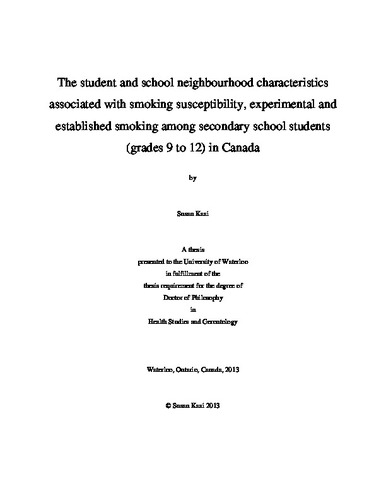| dc.contributor.author | Kaai, Susan | |
| dc.date.accessioned | 2013-01-25 19:28:08 (GMT) | |
| dc.date.available | 2014-07-18 05:00:13 (GMT) | |
| dc.date.issued | 2013-01-25T19:28:08Z | |
| dc.date.submitted | 2013 | |
| dc.identifier.uri | http://hdl.handle.net/10012/7305 | |
| dc.description.abstract | Objective: The purpose of this dissertation was to examine which student- and school-level factors differentiated (1) susceptible never smokers from non-susceptible never smokers, (2) experimental smokers from never smokers, and (3) current smokers from experimental smokers among a nationally representative sample of Canadian students in grade 9-12.
Methods: Student-level data from Canada’s nationally representative 2008-2009 Youth Smoking Survey (2008 YSS) were linked with school-level data from the 2006 Census, and one built environment characteristic, and examined using multi-level logistic regression analyses.
Results: Overall as hypothesized in these three studies, student-level and school-level characteristics were associated with smoking susceptibility among never smokers, experimental smoking and current smoking. The likelihood of susceptibility among never smokers (P=0.0002), experimental smoking (P<0.0001) and current smoking (P<0.001) significantly varied across schools. This study identified that attending a school in an urban (AOR=0.62; 95% CI 0.46-0.82) setting or in a high socioeconomic status (SES) neighbourhood (AOR=0.88; 95% CI 0.79-0.98) was inversely associated with odds of a student being an experimental smoker (versus a never smoker) when adjusting for student-level characteristics. The number of tobacco retailers located within a 1-km radius of each school was associated with the odds of a student being a current smoker (versus an experimental smoker) (AOR 1.03; 95% CI 1.01-1.05) and also associated with a student being a susceptible never smoker (versus a non-susceptible never smoker) (AOR 1.01; 95% CI 1.00-1.02) when adjusting for student-level characteristics. Additionally, several student-level intrapersonal and social context characteristics were associated with smoking susceptibility, experimental smoking and current smoking.
Conclusions: This study showed that the characteristics of the school a student attends may increase their likelihood of a student being in any of the smoking stages that were examined. Additionally, several student-level factors were also associated with the three smoking stages. Understanding these factors will provide more insight to guide stakeholders interested in developing anti-tobacco strategies that are responsive to the risk and protective factors of adolescents in different smoking stages. | en |
| dc.language.iso | en | en |
| dc.publisher | University of Waterloo | en |
| dc.subject | Adolescents | en |
| dc.subject | Tobacco use | en |
| dc.subject | Factors | en |
| dc.subject | Smoking stages | en |
| dc.subject | Multi-level logistic regression | en |
| dc.title | The student and school neighbourhood characteristics associated with smoking susceptibility, experimental and established smoking among secondary school students (grades 9 to 12) in Canada | en |
| dc.type | Doctoral Thesis | en |
| dc.pending | true | en |
| dc.subject.program | Health Studies and Gerontology | en |
| dc.description.embargoterms | 1 year | en |
| uws-etd.degree.department | Health Studies and Gerontology | en |
| uws-etd.degree | Doctor of Philosophy | en |
| uws.typeOfResource | Text | en |
| uws.peerReviewStatus | Unreviewed | en |
| uws.scholarLevel | Graduate | en |

